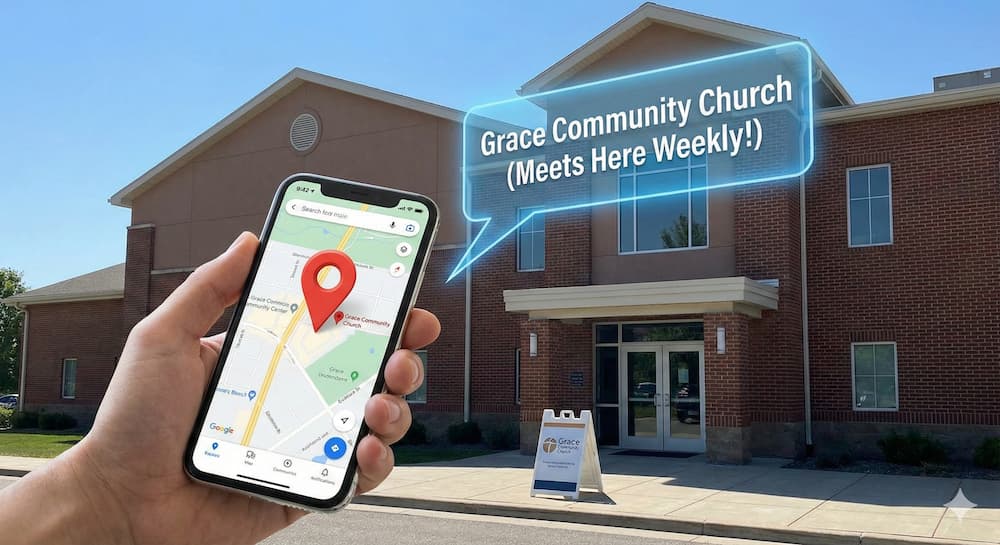When Is the Right Time to Expand Your Church?
Here are 3 metrics and 4 questions to ask when considering this key stage of church development.

Congratulations, pastor. Your church is bursting at the seams. People are driving a half hour or more to attend, and you’ve maxed out your Sunday service slots. You’ve created the greatest problem a ministry could ask for as you seek to reach people for Christ.
So, what’s next? Is it time to expand?
I’m guessing that’s the question that led you to click on this article — and I’m glad you did. As the Principal and Founder at Ministry Solutions Group, my team has seen so many churches experiencing the challenges of growth in the last year.
Let me start by confirming that this is a good thing. I’m so grateful that people like you are out there following God’s call and seeing the fruits of that kingdom work.
That said, church growth comes with a lot of challenges. You’re probably facing — or soon will be facing — things like new mortgage payments, staffing struggles, and the heartbreaking problem of watching new people walk away from a lack of space. (Not everyone is tenacious enough to lower their friends through the roof like in Mark 2.)
If your church feels like it’s at capacity, it’s important to start thinking now, before you start running into visitors who couldn’t find a seat in your auditorium or a parking spot and have shifted from saying “I go to your church” to “I went to your church.”
If you’re feeling the pinch of church growth, you may be asking the question: is it time to expand? As someone who has helped manage and fund over $1 billion in church projects over the past decade, here’s what I’ve learned about how to answer this key question.
The Nuance of Expansion as a Mission-Driven Organization
If a business outgrows its office or warehouse capacity, it takes out a loan, finds a bigger space, and expands. This is a calculated decision that comes from things like running a cost-benefit analysis and gauging opportunity cost.
In the church world, it can feel more complex. After all, you’re running a mission-driven organization, and the truth is, you should absolutely seek God first when considering expansion. That is an added and critical step that a business owner doesn’t have to consider (although they should!).
As you pray, don’t be afraid to be practical with God. While there are qualitative reasons to move or not move a ministry, there are plenty of quantitative ones. Supply and demand is just as real in the church world as it is in the marketplace. If you don’t have enough seats or parking spaces, you’re going to run out of room.
This leads us back to the question of church expansion — although even then, what does expansion mean? Do you want to open up a new campus? Expand a facility? Merge with another church looking for a succession plan? Let’s dig in.
Church Expansion: 3 Metrics to Watch
When it comes to expansion, there are many factors to consider. Here are three of the most important metrics to watch:
Space Efficiency
This is the most obvious one. If you don’t have enough seats for your attendees, that’s a problem. However, keep in mind that the easiest way to get more seats is to use the same seats more. Don’t expand to a multisite model until you’ve absolutely saturated your building and can’t reasonably add any more services.
Time Efficiency
This overlaps with space efficiency. How much time are you spending engaged in church on any given Sunday? Have you hit all of the popular times when people are willing to attend? There is certainly a saturation factor and a law of diminishing returns with multiple services, but make sure you’ve met this before you invest in a big expansion project.
Geography
Where are your people coming from? Are people willing to drive more than 20 minutes to get to you? Because most people won’t drive past 20 minutes to get to yours. This metric can help you see where you have “people density” outside of your immediate reach, and can help you figure out where opening up another location could take the most pressure off of your current Sunday services.
Church Expansion: 4 Questions to Ask
If you’re watching the metrics and you aren’t quite sure if it’s time to expand, here are four questions you can ask your team to gain clarity.
- Are you giving yourself enough runway for the expansion? Church expansions take time. You’re feeling the pressure of church growth, I get it, but make sure you start planning early. Do you have the financial capacity to fund the startup costs and subsidize multisite operational expenses for at least a year – ideally three? Do you have a leadership pipeline in place? Are your current ministries firing on all cylinders? Invest in these areas now to avoid scrambling when you need to make a move.
- What is your primary goal in a church expansion project? Are you trying to ease congestion on Sundays? Do you want to accommodate your current crowd with more space? Be specific here.
- Are you viewing your building with the right mindset? Remember, buildings are just tools. They aren’t strategies in and of themselves. How is your current building factoring into your church growth strategy?
- Have you seriously thought about how you should expand? Do you need more seats? More parking? How many of each? Keep in mind that a new seat for a current attendee at a multisite campus also means another seat in your primary campus’ auditorium.
Expanding Your Church the Right Way
Expanding a church requires purpose, time, and strategy. Don’t wait until it’s too late to start planning. Gather information now so that you can make informed decisions later (even if that later is right around the corner).
Sign Up for Product Updates
Congratulations, pastor. Your church is bursting at the seams. People are driving a half hour or more to attend, and you’ve maxed out your Sunday service slots. You’ve created the greatest problem a ministry could ask for as you seek to reach people for Christ.
So, what’s next? Is it time to expand?
I’m guessing that’s the question that led you to click on this article — and I’m glad you did. As the Principal and Founder at Ministry Solutions Group, my team has seen so many churches experiencing the challenges of growth in the last year.
Let me start by confirming that this is a good thing. I’m so grateful that people like you are out there following God’s call and seeing the fruits of that kingdom work.
That said, church growth comes with a lot of challenges. You’re probably facing — or soon will be facing — things like new mortgage payments, staffing struggles, and the heartbreaking problem of watching new people walk away from a lack of space. (Not everyone is tenacious enough to lower their friends through the roof like in Mark 2.)
If your church feels like it’s at capacity, it’s important to start thinking now, before you start running into visitors who couldn’t find a seat in your auditorium or a parking spot and have shifted from saying “I go to your church” to “I went to your church.”
If you’re feeling the pinch of church growth, you may be asking the question: is it time to expand? As someone who has helped manage and fund over $1 billion in church projects over the past decade, here’s what I’ve learned about how to answer this key question.
The Nuance of Expansion as a Mission-Driven Organization
If a business outgrows its office or warehouse capacity, it takes out a loan, finds a bigger space, and expands. This is a calculated decision that comes from things like running a cost-benefit analysis and gauging opportunity cost.
In the church world, it can feel more complex. After all, you’re running a mission-driven organization, and the truth is, you should absolutely seek God first when considering expansion. That is an added and critical step that a business owner doesn’t have to consider (although they should!).
As you pray, don’t be afraid to be practical with God. While there are qualitative reasons to move or not move a ministry, there are plenty of quantitative ones. Supply and demand is just as real in the church world as it is in the marketplace. If you don’t have enough seats or parking spaces, you’re going to run out of room.
This leads us back to the question of church expansion — although even then, what does expansion mean? Do you want to open up a new campus? Expand a facility? Merge with another church looking for a succession plan? Let’s dig in.
Church Expansion: 3 Metrics to Watch
When it comes to expansion, there are many factors to consider. Here are three of the most important metrics to watch:
Space Efficiency
This is the most obvious one. If you don’t have enough seats for your attendees, that’s a problem. However, keep in mind that the easiest way to get more seats is to use the same seats more. Don’t expand to a multisite model until you’ve absolutely saturated your building and can’t reasonably add any more services.
Time Efficiency
This overlaps with space efficiency. How much time are you spending engaged in church on any given Sunday? Have you hit all of the popular times when people are willing to attend? There is certainly a saturation factor and a law of diminishing returns with multiple services, but make sure you’ve met this before you invest in a big expansion project.
Geography
Where are your people coming from? Are people willing to drive more than 20 minutes to get to you? Because most people won’t drive past 20 minutes to get to yours. This metric can help you see where you have “people density” outside of your immediate reach, and can help you figure out where opening up another location could take the most pressure off of your current Sunday services.
Church Expansion: 4 Questions to Ask
If you’re watching the metrics and you aren’t quite sure if it’s time to expand, here are four questions you can ask your team to gain clarity.
- Are you giving yourself enough runway for the expansion? Church expansions take time. You’re feeling the pressure of church growth, I get it, but make sure you start planning early. Do you have the financial capacity to fund the startup costs and subsidize multisite operational expenses for at least a year – ideally three? Do you have a leadership pipeline in place? Are your current ministries firing on all cylinders? Invest in these areas now to avoid scrambling when you need to make a move.
- What is your primary goal in a church expansion project? Are you trying to ease congestion on Sundays? Do you want to accommodate your current crowd with more space? Be specific here.
- Are you viewing your building with the right mindset? Remember, buildings are just tools. They aren’t strategies in and of themselves. How is your current building factoring into your church growth strategy?
- Have you seriously thought about how you should expand? Do you need more seats? More parking? How many of each? Keep in mind that a new seat for a current attendee at a multisite campus also means another seat in your primary campus’ auditorium.
Expanding Your Church the Right Way
Expanding a church requires purpose, time, and strategy. Don’t wait until it’s too late to start planning. Gather information now so that you can make informed decisions later (even if that later is right around the corner).
podcast transcript
Congratulations, pastor. Your church is bursting at the seams. People are driving a half hour or more to attend, and you’ve maxed out your Sunday service slots. You’ve created the greatest problem a ministry could ask for as you seek to reach people for Christ.
So, what’s next? Is it time to expand?
I’m guessing that’s the question that led you to click on this article — and I’m glad you did. As the Principal and Founder at Ministry Solutions Group, my team has seen so many churches experiencing the challenges of growth in the last year.
Let me start by confirming that this is a good thing. I’m so grateful that people like you are out there following God’s call and seeing the fruits of that kingdom work.
That said, church growth comes with a lot of challenges. You’re probably facing — or soon will be facing — things like new mortgage payments, staffing struggles, and the heartbreaking problem of watching new people walk away from a lack of space. (Not everyone is tenacious enough to lower their friends through the roof like in Mark 2.)
If your church feels like it’s at capacity, it’s important to start thinking now, before you start running into visitors who couldn’t find a seat in your auditorium or a parking spot and have shifted from saying “I go to your church” to “I went to your church.”
If you’re feeling the pinch of church growth, you may be asking the question: is it time to expand? As someone who has helped manage and fund over $1 billion in church projects over the past decade, here’s what I’ve learned about how to answer this key question.
The Nuance of Expansion as a Mission-Driven Organization
If a business outgrows its office or warehouse capacity, it takes out a loan, finds a bigger space, and expands. This is a calculated decision that comes from things like running a cost-benefit analysis and gauging opportunity cost.
In the church world, it can feel more complex. After all, you’re running a mission-driven organization, and the truth is, you should absolutely seek God first when considering expansion. That is an added and critical step that a business owner doesn’t have to consider (although they should!).
As you pray, don’t be afraid to be practical with God. While there are qualitative reasons to move or not move a ministry, there are plenty of quantitative ones. Supply and demand is just as real in the church world as it is in the marketplace. If you don’t have enough seats or parking spaces, you’re going to run out of room.
This leads us back to the question of church expansion — although even then, what does expansion mean? Do you want to open up a new campus? Expand a facility? Merge with another church looking for a succession plan? Let’s dig in.
Church Expansion: 3 Metrics to Watch
When it comes to expansion, there are many factors to consider. Here are three of the most important metrics to watch:
Space Efficiency
This is the most obvious one. If you don’t have enough seats for your attendees, that’s a problem. However, keep in mind that the easiest way to get more seats is to use the same seats more. Don’t expand to a multisite model until you’ve absolutely saturated your building and can’t reasonably add any more services.
Time Efficiency
This overlaps with space efficiency. How much time are you spending engaged in church on any given Sunday? Have you hit all of the popular times when people are willing to attend? There is certainly a saturation factor and a law of diminishing returns with multiple services, but make sure you’ve met this before you invest in a big expansion project.
Geography
Where are your people coming from? Are people willing to drive more than 20 minutes to get to you? Because most people won’t drive past 20 minutes to get to yours. This metric can help you see where you have “people density” outside of your immediate reach, and can help you figure out where opening up another location could take the most pressure off of your current Sunday services.
Church Expansion: 4 Questions to Ask
If you’re watching the metrics and you aren’t quite sure if it’s time to expand, here are four questions you can ask your team to gain clarity.
- Are you giving yourself enough runway for the expansion? Church expansions take time. You’re feeling the pressure of church growth, I get it, but make sure you start planning early. Do you have the financial capacity to fund the startup costs and subsidize multisite operational expenses for at least a year – ideally three? Do you have a leadership pipeline in place? Are your current ministries firing on all cylinders? Invest in these areas now to avoid scrambling when you need to make a move.
- What is your primary goal in a church expansion project? Are you trying to ease congestion on Sundays? Do you want to accommodate your current crowd with more space? Be specific here.
- Are you viewing your building with the right mindset? Remember, buildings are just tools. They aren’t strategies in and of themselves. How is your current building factoring into your church growth strategy?
- Have you seriously thought about how you should expand? Do you need more seats? More parking? How many of each? Keep in mind that a new seat for a current attendee at a multisite campus also means another seat in your primary campus’ auditorium.
Expanding Your Church the Right Way
Expanding a church requires purpose, time, and strategy. Don’t wait until it’s too late to start planning. Gather information now so that you can make informed decisions later (even if that later is right around the corner).
VIDEO transcript
Congratulations, pastor. Your church is bursting at the seams. People are driving a half hour or more to attend, and you’ve maxed out your Sunday service slots. You’ve created the greatest problem a ministry could ask for as you seek to reach people for Christ.
So, what’s next? Is it time to expand?
I’m guessing that’s the question that led you to click on this article — and I’m glad you did. As the Principal and Founder at Ministry Solutions Group, my team has seen so many churches experiencing the challenges of growth in the last year.
Let me start by confirming that this is a good thing. I’m so grateful that people like you are out there following God’s call and seeing the fruits of that kingdom work.
That said, church growth comes with a lot of challenges. You’re probably facing — or soon will be facing — things like new mortgage payments, staffing struggles, and the heartbreaking problem of watching new people walk away from a lack of space. (Not everyone is tenacious enough to lower their friends through the roof like in Mark 2.)
If your church feels like it’s at capacity, it’s important to start thinking now, before you start running into visitors who couldn’t find a seat in your auditorium or a parking spot and have shifted from saying “I go to your church” to “I went to your church.”
If you’re feeling the pinch of church growth, you may be asking the question: is it time to expand? As someone who has helped manage and fund over $1 billion in church projects over the past decade, here’s what I’ve learned about how to answer this key question.
The Nuance of Expansion as a Mission-Driven Organization
If a business outgrows its office or warehouse capacity, it takes out a loan, finds a bigger space, and expands. This is a calculated decision that comes from things like running a cost-benefit analysis and gauging opportunity cost.
In the church world, it can feel more complex. After all, you’re running a mission-driven organization, and the truth is, you should absolutely seek God first when considering expansion. That is an added and critical step that a business owner doesn’t have to consider (although they should!).
As you pray, don’t be afraid to be practical with God. While there are qualitative reasons to move or not move a ministry, there are plenty of quantitative ones. Supply and demand is just as real in the church world as it is in the marketplace. If you don’t have enough seats or parking spaces, you’re going to run out of room.
This leads us back to the question of church expansion — although even then, what does expansion mean? Do you want to open up a new campus? Expand a facility? Merge with another church looking for a succession plan? Let’s dig in.
Church Expansion: 3 Metrics to Watch
When it comes to expansion, there are many factors to consider. Here are three of the most important metrics to watch:
Space Efficiency
This is the most obvious one. If you don’t have enough seats for your attendees, that’s a problem. However, keep in mind that the easiest way to get more seats is to use the same seats more. Don’t expand to a multisite model until you’ve absolutely saturated your building and can’t reasonably add any more services.
Time Efficiency
This overlaps with space efficiency. How much time are you spending engaged in church on any given Sunday? Have you hit all of the popular times when people are willing to attend? There is certainly a saturation factor and a law of diminishing returns with multiple services, but make sure you’ve met this before you invest in a big expansion project.
Geography
Where are your people coming from? Are people willing to drive more than 20 minutes to get to you? Because most people won’t drive past 20 minutes to get to yours. This metric can help you see where you have “people density” outside of your immediate reach, and can help you figure out where opening up another location could take the most pressure off of your current Sunday services.
Church Expansion: 4 Questions to Ask
If you’re watching the metrics and you aren’t quite sure if it’s time to expand, here are four questions you can ask your team to gain clarity.
- Are you giving yourself enough runway for the expansion? Church expansions take time. You’re feeling the pressure of church growth, I get it, but make sure you start planning early. Do you have the financial capacity to fund the startup costs and subsidize multisite operational expenses for at least a year – ideally three? Do you have a leadership pipeline in place? Are your current ministries firing on all cylinders? Invest in these areas now to avoid scrambling when you need to make a move.
- What is your primary goal in a church expansion project? Are you trying to ease congestion on Sundays? Do you want to accommodate your current crowd with more space? Be specific here.
- Are you viewing your building with the right mindset? Remember, buildings are just tools. They aren’t strategies in and of themselves. How is your current building factoring into your church growth strategy?
- Have you seriously thought about how you should expand? Do you need more seats? More parking? How many of each? Keep in mind that a new seat for a current attendee at a multisite campus also means another seat in your primary campus’ auditorium.
Expanding Your Church the Right Way
Expanding a church requires purpose, time, and strategy. Don’t wait until it’s too late to start planning. Gather information now so that you can make informed decisions later (even if that later is right around the corner).


















.jpg)









